Study on the Effect of the Copper Tailing Substrate with Different Treatments on the Growth of Tall Fescue (Festuca arundinacea)
Abstract
1. Introduction
2. Materials and Methods
2.1. Materials
2.1.1. Plants Materials
2.1.2. Other Materials
2.2. Experimental Design and Treatments
2.3. Plant Analysis and Statistical Analysis
3. Results
3.1. Influence of Different Exogenous Substrates on the pH Value of Copper Tailings
3.2. Effects of Different Exogenous Substrates on the Biomass and Plant Height of Tall Fescue
3.3. Effects of Different Exogenous Substrates on the Content of Chlorophyll and CAT Activity in Tall Fescue
3.4. Effects of Different Exogenous Substrates on Cu2+ Transport in Tall Fescue
4. Discussion
5. Conclusions and Outlook
Author Contributions
Funding
Institutional Review Board Statement
Informed Consent Statement
Data Availability Statement
Conflicts of Interest
References
- Guo, X.; Wang, Q.; Liu, Y.; Zhang, X.; Fan, S. Screening of salt stress responsive genes in Brachypodium distachyon (L.) Beauv. by transcriptome analysis. Plants 2020, 9, 1522. [Google Scholar] [CrossRef] [PubMed]
- Li, C.; Xie, S.; You, F.; Zhu, X.; Li, J.; Xu, X.; Yu, G.; Wang, Y.; Angelidaki, I. Heavy metal stabilization and improved biochar generation via pyrolysis of hydrothermally treated sewage sludge with antibiotic mycelial residue. Waste Manag. 2021, 119, 152–161. [Google Scholar] [CrossRef] [PubMed]
- Siedt, M.; Schäffer, A.; Smith, K.E.; Nabel, M.; Roß-Nickoll, M.; van Dongen, J.T. Comparing straw, compost, and biochar regarding their suitability as agricultural soil amendments to affect soil structure, nutrient leaching, microbial communities, and the fate of pesticides. Sci. Total Environ. 2020, 751, 141607. [Google Scholar] [CrossRef] [PubMed]
- Lam, E.J.; Cánovas, M.; Gálvez, M.E.; Montofré, Í.L.; Keith, B.F.; Faz, Á. Evaluation of the phytoremediation potential of native plants growing on a copper mine tailing in northern chile. J. Geochem. Explor. 2017, 182, 210–217. [Google Scholar] [CrossRef]
- Maric, M.; Antonijevic, M.; Alagic, S. The investigation of the possibility for using some wild and cultivated plants as hyperaccumulators of heavy metals from contaminated soil. Environ. Sci. Pollut. Res. 2013, 20, 1181–1188. [Google Scholar] [CrossRef]
- Tzortzis, M.; Tsertos, H. Determination of thorium, uranium and potassium elemental concentrations in surface soils in Cyprus. J. Environ. Radioact. 2004, 77, 325–338. [Google Scholar] [CrossRef] [PubMed]
- Marta, J.; Rorat, A.; Grobelak, A. Enzymatic assays confirm the toxicity reduction after manure treatment of heavy metals contaminated soil. S. Afr. J. Bot. 2019, 124, 47–53. [Google Scholar] [CrossRef]
- Xue, J.C.; He, M.; Wu, C.F.; Zhang, Z.Y.; Tan, L. Adaptable plants for acidic wastewater sediment of copper sulfide mines. Environ. Eng. Manag. J. 2020, 19, 1475–1480. [Google Scholar] [CrossRef]
- Fischer, S.; Spielau, T.; Clemens, S. Natural variation in Arabidopsis thaliana Cd responses and the detection of quantitative trait loci affecting Cd tolerance. Sci. Rep. 2017, 7, 3693. [Google Scholar] [CrossRef]
- Zhu, H.; Ai, H.; Hu, Z.; Du, D.; Sun, J.; Chen, K.; Chen, L. Comparative transcriptome combined with metabolome analyses revealed key factors involved in nitric oxide (NO)-regulated cadmium stress adaptation in tall fescue. BMC Genom. 2020, 21, 601. [Google Scholar] [CrossRef]
- Lou, Y.; Zhao, P.; Wang, D.; Amombo, E.; Sun, X.; Wang, H.; Zhuge, Y. Germination, physiological responses and gene expression of tall fescue (Festuca arundinacea Schreb.) growing under Pb and Cd. PLoS ONE 2017, 12, e0169495. [Google Scholar] [CrossRef] [PubMed]
- Lan, C.Y.; Shu, W.S.; Wong, M.H. Reclamation of Pb/Zn mine tailings at Shaoguan, Guangdong Province, People’s Republic of China: The role of river sediment and domestic refuse. Bioresour. Technol. 1998, 65, 117–124. [Google Scholar] [CrossRef]
- Ye, Z.H.; Wong, J.W.C.; Wong, M.H.; Lan, C.Y.; Baker, A.J.M. Lime and pig manure as ameliorants for revegetating lead/zinc mine tailings: A greenhouse study. Bioresour. Technol. 1999, 69, 35–43. [Google Scholar] [CrossRef]
- Fellet, G.; Marchiol, L.; Delle Vedove, G.; Peressotti, A. Application of biochar on mine tailings: Effects and perspectives for land reclamation. Chemosphere 2011, 83, 1262–1267. [Google Scholar] [CrossRef]
- Juwarkar, A.A.; Jambhulkar, H.P. Phytoremediation of coal mine spoil dump through integrated biotechnological approach. Bioresour. Technol. 2008, 99, 4732–4741. [Google Scholar] [CrossRef]
- Mallarino, A.P.; Borges, R. Phosphorus and potassium distribution in soil following long-term deep-band fertilization in different tillage systems. Soil Sci. Soc. Am. J. 2006, 70, 702–707. [Google Scholar] [CrossRef]
- Kumar, G.P.; Yadav, S.K.; Thawale, P.R.; Singh, S.K.; Juwarkar, A.A. Growth of Jatropha curcas on heavy metal contaminated soil amended with industrial wastes and Azotobacter–A greenhouse study. Bioresour. Technol. 2008, 99, 2078–2082. [Google Scholar] [CrossRef]
- Hernández-Apaolaza, L.; Escribano, L.; Zamarreño, Á.M.; García-Mina, J.M.; Cano, C.; Carrasco-Gil, S. Root silicon addition induces Fe deficiency in cucumber plants, but facilitates their recovery after Fe resupply. A comparison with Si foliar sprays. Front. Plant Sci. 2020, 11, 580552. [Google Scholar] [CrossRef]
- Jensen, M.B.; de Jonge, N.; Dolriis, M.D.; Kragelund, C.; Fischer, C.H.; Eskesen, M.R.; Noer, K.; Møller, H.B.; Ottosen, L.D.M.; Nielsen, J.L.; et al. Cellulolytic and Xylanolytic Microbial Communities Associated with Lignocellulose-Rich Wheat Straw Degradation in Anaerobic Digestion. Front. Microbiol. 2021, 12, 645174. [Google Scholar] [CrossRef]
- Zhou, M.; Yang, H.; Zheng, D.; Pu, X.; Liu, Y.; Wang, L.; Zhang, Y.; Deng, L. Methanogenic activity and microbial communities characteristics in dry and wet anaerobic digestion sludges from swine manure. Biochem. Eng. J. 2019, 152, 107390. [Google Scholar] [CrossRef]
- Zhang, Y.; Zhang, L.; Guo, B.; Zhou, Y.; Gao, M.; Sharaf, A.; Liu, Y. Granular activated carbon stimulated microbial physiological changes for enhanced anaerobic digestion of municipal sewage. Chem. Eng. J. 2020, 400, 125838. [Google Scholar] [CrossRef]
- Bi, Q.F.; Chen, Q.H.; Yang, X.R.; Li, H.; Zheng, B.X.; Zhou, W.W.; Liu, X.-X.; Dai, P.-B.; Li, K.-J.; Lin, X.Y. Effects of combined application of nitrogen fertilizer and biochar on the nitrification and ammonia oxidizers in an intensive vegetable soil. AMB Express 2017, 7, 198. [Google Scholar] [CrossRef] [PubMed]
- Jarukas, L.; Ivanauskas, L.; Kasparaviciene, G.; Baranauskaite, J.; Marksa, M.; Bernatoniene, J. Determination of organic compounds, fulvic acid, humic acid, and humin in peat and sapropel alkaline extracts. Molecules 2021, 26, 2995. [Google Scholar] [CrossRef] [PubMed]
- Bernardi, A.; Oliveira, C. Improved alfalfa phosphate utilization using zeolite amendments in low ph soil. J. Soil Sci. Plant Nutr. 2021, 21, 1307–1317. [Google Scholar] [CrossRef]
- Guimaraes, H.I.P.; Santana, R.H.; Silveira, R.; Pinto, O.H.B.; Quirino, B.F.; Barreto, C.C.; Krüger, R.H. Seasonal variations in soil microbiota profile of termite (Syntermes wheeleri) mounds in the Brazilian tropical savanna. Microorganisms 2020, 8, 1482. [Google Scholar] [CrossRef]
- Tan, Z.; Yu, F.; Liu, L.; Jia, X.; Lv, Y.; Chen, L.; Xu, Y.; Shi, Y.; Guo, X. Cu-doped porous carbon derived from heavy metal-contaminated sewage sludge for high-performance supercapacitor electrode materials. Nanomaterials 2019, 9, 892. [Google Scholar] [CrossRef]
- Mackie, A.L.; Walsh, M.E. Bench-scale comparison of conventional and high rate clarification treatment processes for acid mine drainage. Water Qual. Res. J. Can. 2015, 50, 279. [Google Scholar] [CrossRef]
- Luo, X.; Li, Y.; Wu, Q.; Wei, Z.; Li, Q.; Wei, L.; Shen, Y.; Wang, R. Characteristics of internal ammonium loading from long-term polluted sediments by rural domestic wastewater. Int. J. Environ. Res. Public Health 2019, 16, 4657. [Google Scholar] [CrossRef]
- Ogawa, Y.; Tokunaga, E.; Kobayashi, O.; Hirai, K.; Shibata, N. Current contributions of organofluorine compounds to the agrochemical industry. iScience 2020, 23, 101467. [Google Scholar] [CrossRef]
- Zhang, X.; Yang, H.; Cui, Z. Evaluation and analysis of soil migration and distribution characteristics of heavy metals in iron tailings. J. Clean. Prod. 2018, 172, 475–480. [Google Scholar] [CrossRef]
- Tuteja, N.; Mahajan, S. Calcium signaling network in plants: An overview. Plant Signal. Behav. 2007, 2, 79–85. [Google Scholar] [CrossRef] [PubMed]
- Verma, S.; Sharma, A.; Kumar, R.; Kaur, C.; Arora, A.; Shah, R.; Nain, L. Improvement of antioxidant and defense properties of Tomato (var. Pusa Rohini) by application of bioaugmented compost. Saudi J. Biol. Sci. 2015, 22, 256–264. [Google Scholar] [CrossRef] [PubMed]
- Machado, N.; Leite, M.G.P.; Figueiredo, M.A.; Kozovits, A.R. Growing Eremanthus erythropappus in crushed laterite: A promising alternative to topsoil for bauxite-mine revegetation. J. Environ. Manag. 2013, 129, 149–156. [Google Scholar] [CrossRef] [PubMed]
- Mackie, A.L.; Walsh, M.E. Investigation into the use of cement kiln dust in high density sludge (HDS) treatment of acid mine water. Water Res. 2015, 85, 443–450. [Google Scholar] [CrossRef] [PubMed]
- Sharma, R.; Kaur, R. Elucidating physiological and biochemical alterations in giant duckweed (Spirodela polyrhiza L. Schleiden) under diethyl phthalate stress: Insights into antioxidant defence system. PeerJ 2020, 8, e8267. [Google Scholar] [CrossRef]
- Malar, S.; Vikram, S.S.; Favas, P.J.; Perumal, V. Lead heavy metal toxicity induced changes on growth and antioxidative enzymes level in water hyacinths [Eichhornia crassipes (mart.)]. Bot. Stud. 2016, 55, 54. [Google Scholar] [CrossRef]
- Pérez, R.; Tapia, Y.; Antilén, M.; Casanova, M.; Vidal, C.; Santander, C.; Aponte, H.; Cornejo, P. Interactive effect of compost application and inoculation with the fungus Claroideoglomus claroideum in Oenothera picensis plants growing in mine tailings. Ecotoxicol. Environ. Saf. 2021, 208, 111495. [Google Scholar] [CrossRef]
- Zhang, H.X.; Ali, M.; Feng, X.H.; Jin, J.H.; Huang, L.J.; Khan, A.; Lv, J.-G.; Gao, S.-Y.; Luo, D.-X.; Gong, Z.H. A novel transcription factor CaSBP12 gene negatively regulates the defense response against Phytophthora capsici in pepper (Capsicum annuum L.). Int. J. Mol. Sci. 2019, 20, 48. [Google Scholar] [CrossRef]
- Reid, N.B.; Naeth, M.A. Establishment of a Vegetation Cover on Tundra Kimberlite Mine Tailings: 2. A Field Study. Restor. Ecol. 2005, 13, 602–608. [Google Scholar] [CrossRef]
- Wang, Y.; Li, S.; Ma, L.; Dong, S.; Liu, L. Corn stalk as starting material to prepare a novel adsorbent via SET-LRP and its adsorption performance for Pb (II) and Cu (II). R. Soc. Open Sci. 2020, 7, 191811. [Google Scholar] [CrossRef]
- Mori, A.S.; Cornelissen, J.; Fujii, S.; Okada, K.I.; Isbell, F. A meta-analysis on decomposition quantifies afterlife effects of plant diversity as a global change driver. Nat. Commun. 2020, 11, 4547. [Google Scholar] [CrossRef] [PubMed]
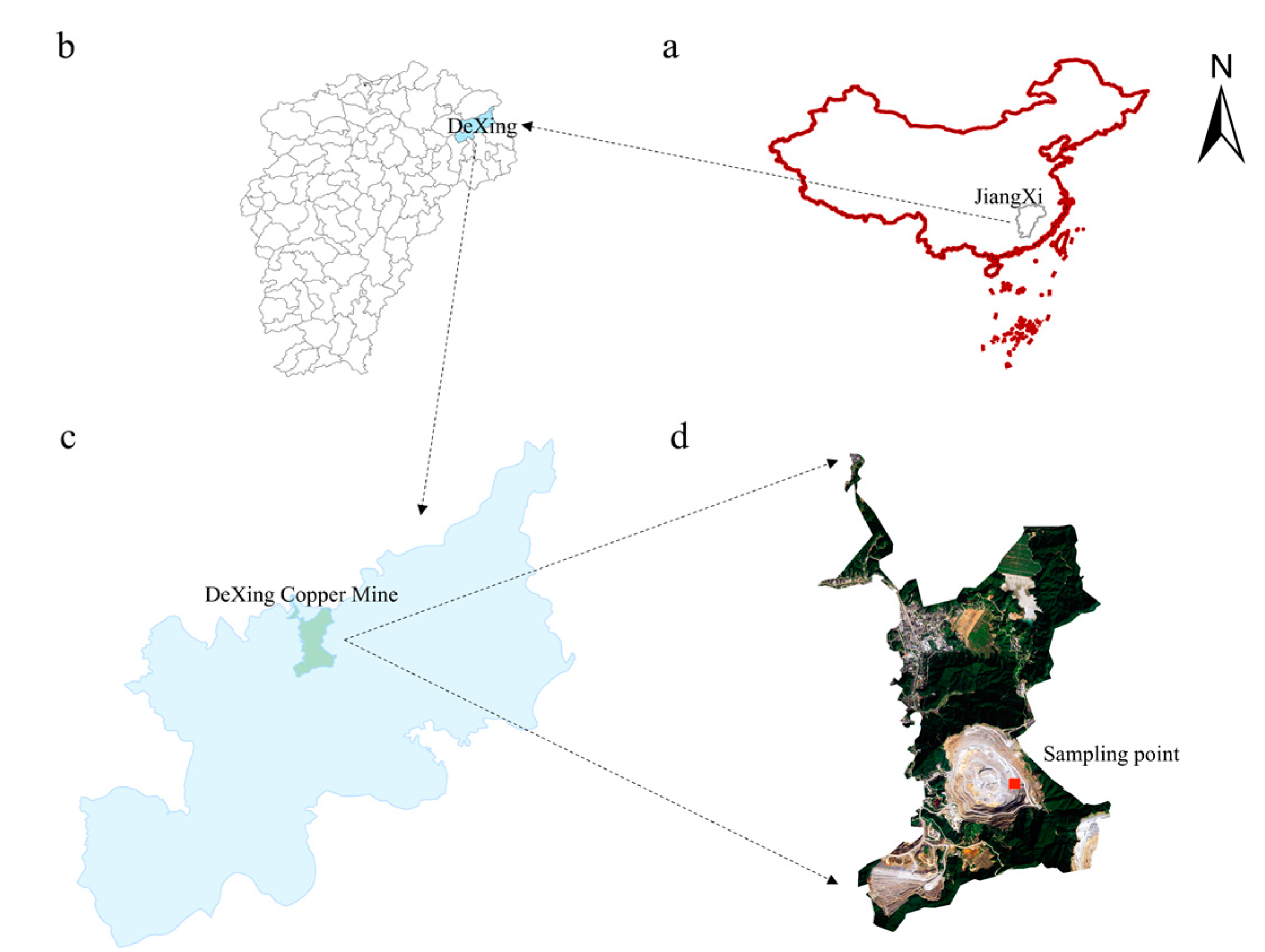
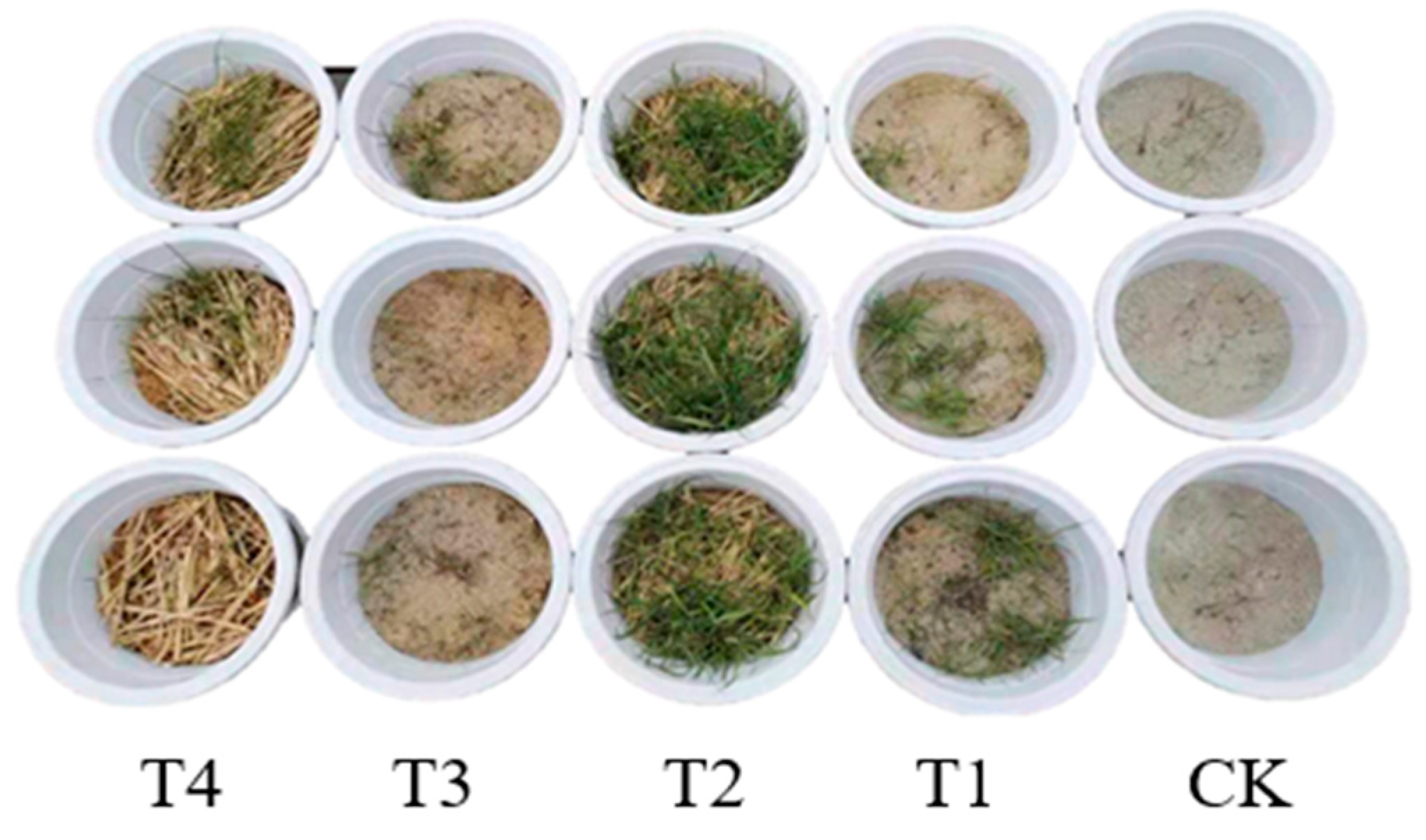
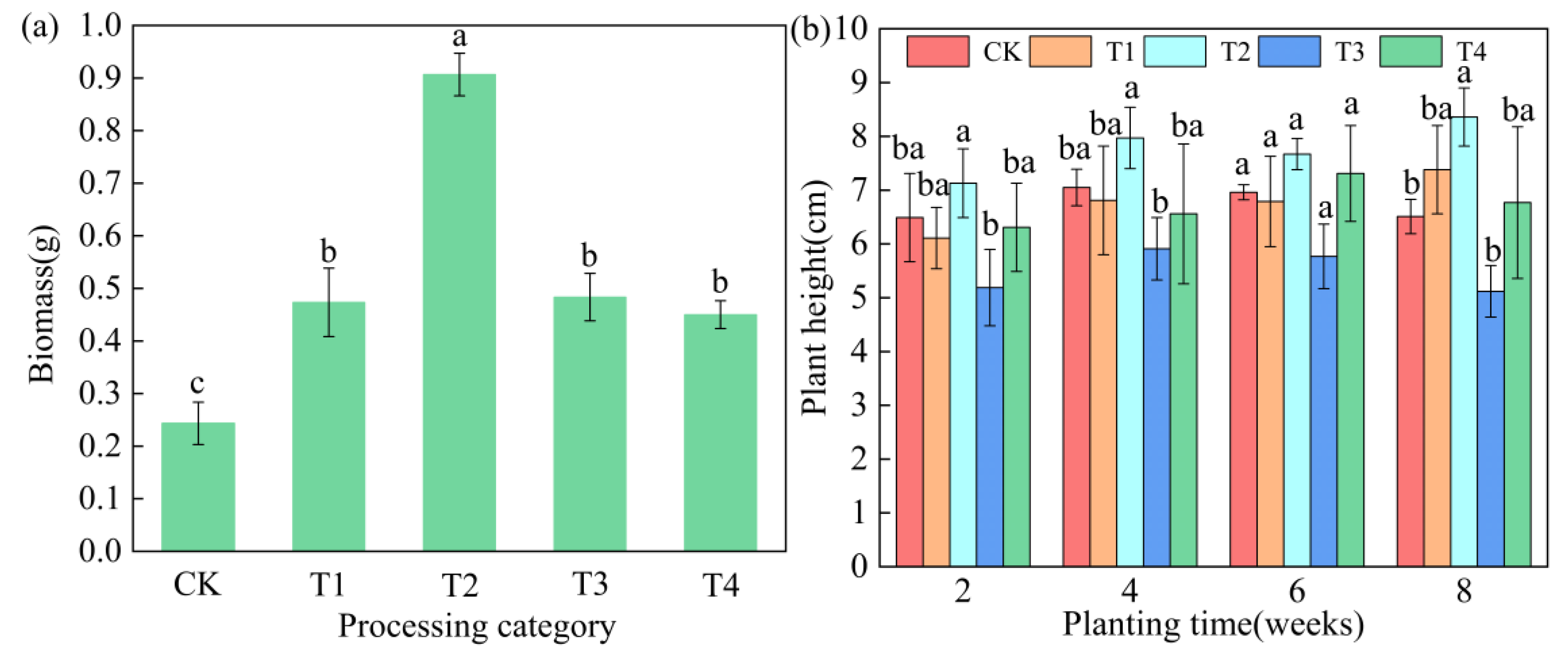
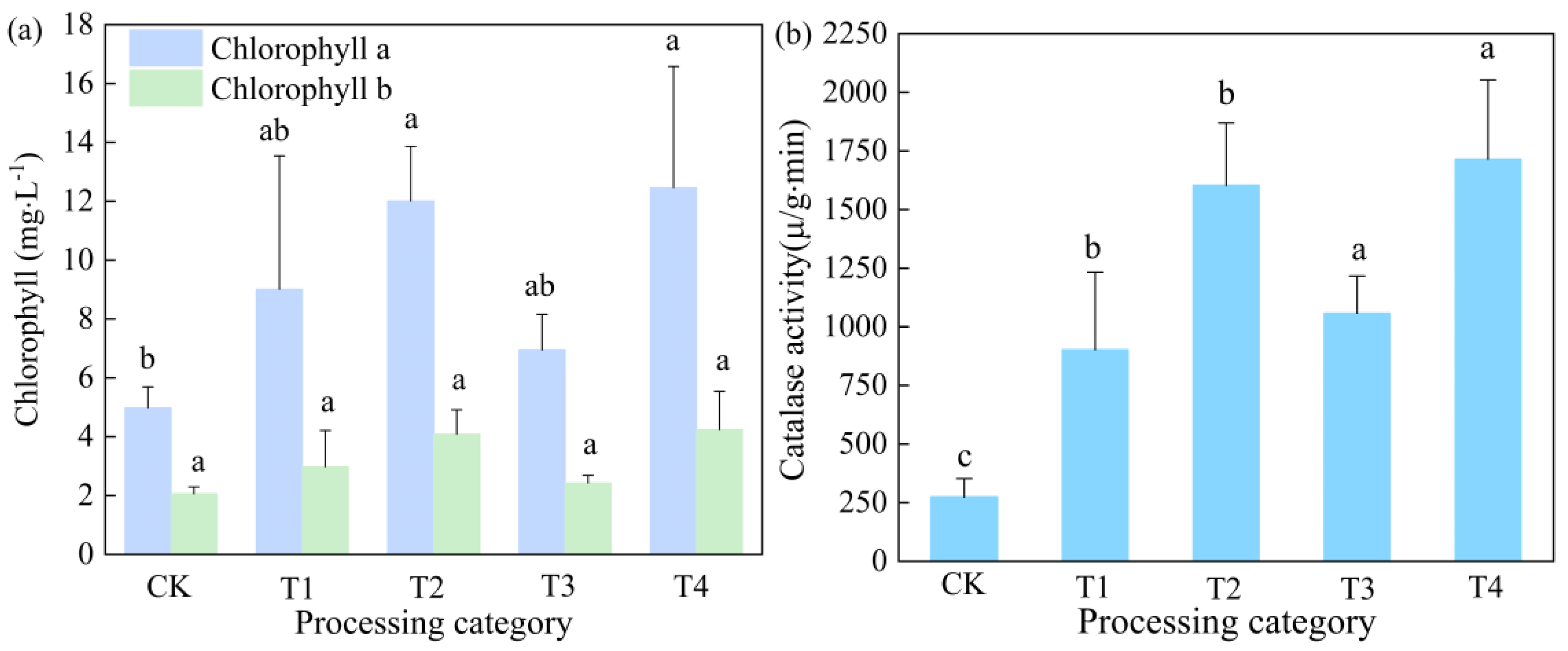
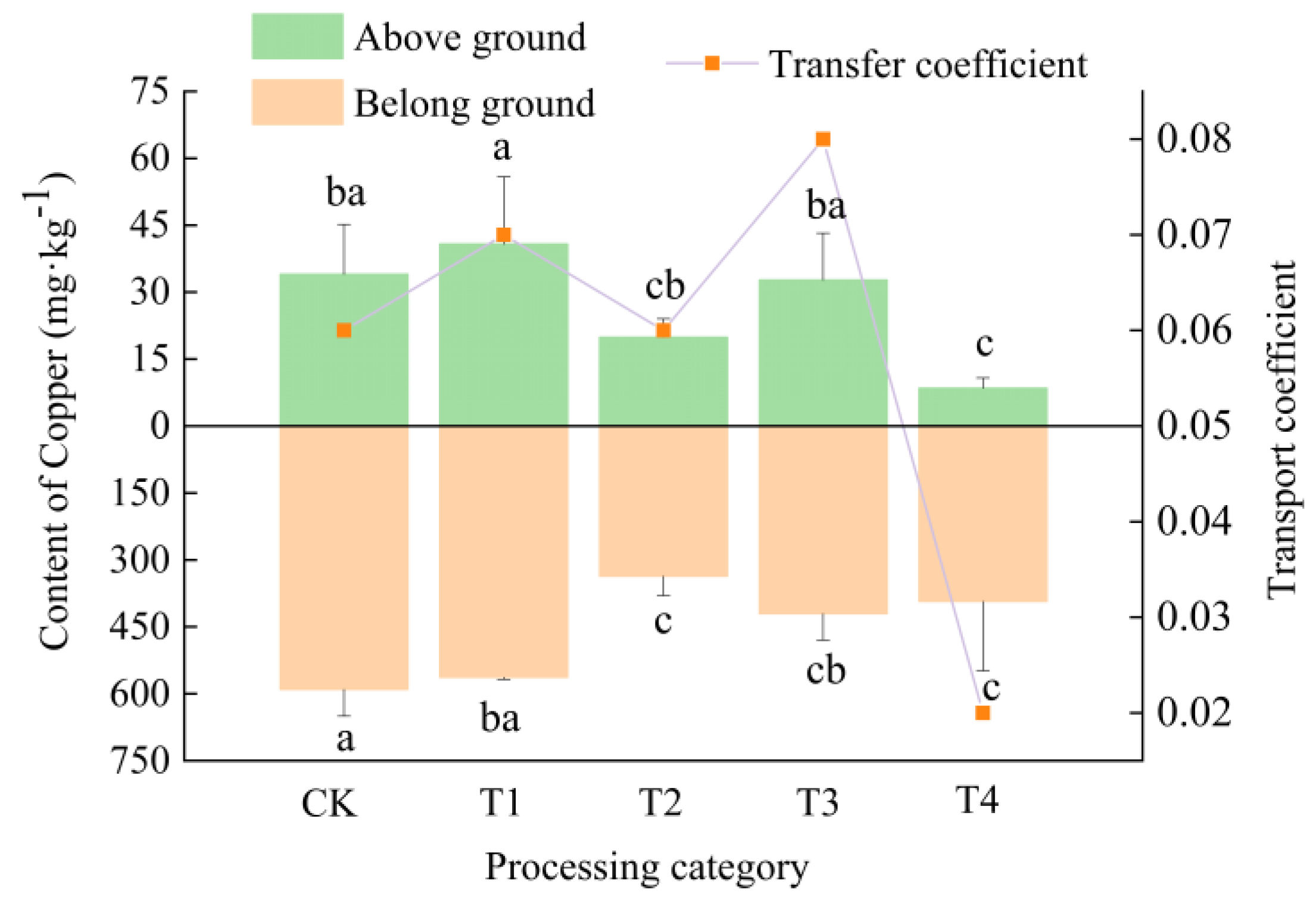
| Treatment | CK | T1 | T2 | T3 | T4 |
|---|---|---|---|---|---|
| pH of unplanted tall fescue substrate | 8.83 ± 0.04 a | 8.44 ± 0.07 b | 7.45 ± 0.05 d | 7.01 ± 0.01 e | 7.77 ± 0.03 c |
| Substrate pH after planting tall fescue for 2 months | 9.29 ± 0.04 a | 8.49 ± 0.13 b | 7.95 ± 0.12 c | 8.52 ± 0.20 b | 7.99 ± 0.03 c |
Publisher’s Note: MDPI stays neutral with regard to jurisdictional claims in published maps and institutional affiliations. |
© 2022 by the authors. Licensee MDPI, Basel, Switzerland. This article is an open access article distributed under the terms and conditions of the Creative Commons Attribution (CC BY) license (https://creativecommons.org/licenses/by/4.0/).
Share and Cite
Xue, J.; Wang, W.; He, M.; You, J.; Han, H. Study on the Effect of the Copper Tailing Substrate with Different Treatments on the Growth of Tall Fescue (Festuca arundinacea). Sustainability 2022, 14, 15387. https://doi.org/10.3390/su142215387
Xue J, Wang W, He M, You J, Han H. Study on the Effect of the Copper Tailing Substrate with Different Treatments on the Growth of Tall Fescue (Festuca arundinacea). Sustainability. 2022; 14(22):15387. https://doi.org/10.3390/su142215387
Chicago/Turabian StyleXue, Jinchun, Weiwei Wang, Min He, Jiajia You, and Huaqin Han. 2022. "Study on the Effect of the Copper Tailing Substrate with Different Treatments on the Growth of Tall Fescue (Festuca arundinacea)" Sustainability 14, no. 22: 15387. https://doi.org/10.3390/su142215387
APA StyleXue, J., Wang, W., He, M., You, J., & Han, H. (2022). Study on the Effect of the Copper Tailing Substrate with Different Treatments on the Growth of Tall Fescue (Festuca arundinacea). Sustainability, 14(22), 15387. https://doi.org/10.3390/su142215387






